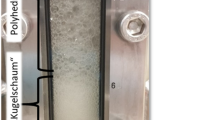Abstract
Aspergillus flavusresting cells were washed with solvents of different polarity for 2, 6, and 24 h and then suspended in isooctane containing either oleic acid and 1-propanol or 1-propanol alone. Propyl oleate and propyl linoleate were produced in all experiments after 24 h due to the presence of residual fatty acids originating from the sunflower oil used for growing the mycelium. After 24 h washing, most solvents produced a 70 to 90% decrease in lipase activity and a 0 to 99% decrease in the amount of residual acids. 0.7 M 1-propanol in hexane was the best washing solvent among all those assayed (93% remaining activity, 0.3% residual oleic acid).
Similar content being viewed by others
References
Chen JP, Wang JB (1997) Wax ester synthesis by lipase-catalyzed esterification with fungal cells immobilized on cellulose biomass support particles. Enzyme Microbiol. Technol. 20: 615-622.
Drauz K, Waldmann H (1995) Enzyme Catalysis in Organic Synthesis.Weinheim: VCH.
Fukunaga K, Minamijima N, Sugimura Y, Zhang ZZ, Nakao K (1997) Immobilization of organic solvent-soluble lipase in nonaqueous conditions and properties of the immobilized enzymes. J. Biotechnol. 52: 81-88.
Hara F, Nakashima T (1996) Transesterification of phospholipids by acetone-dried cells of a Rhizopusspecies immobilized on biomass support particles. J. Amer. Oil Chem. Soc. 73: 657-659.
Long K, Ghazali HM, Ariff A, Man YBC, Bucke C (1998) Substrate preference of mycelium-bound lipase from a strain of Aspergillus flavusLink. Biotechnol. Lett. 20: 369-372.
Loscos V, Cañes G, Perpiña B, Torres M, Sala N, Canela R (1998) An Aspergillus flavusstrain promoting oleic acid esterification in isooctane. In: Ballesteros A, Plou FJ, Iborra JL, Halling P, eds. Stability and Stabilization of Biocatalysts, Progress in Biotechnology 15. Amsterdam: Elsevier Science, pp. 657-660.
Miura T, Yamane T (1997) Screening for fungi that have high lipolytic and acidolytic activities in biomass support particles. Biosci. Biotech. Biochem. 61: 1252-1257.
Molinari F, Marianelli G, Aragozzini F (1995) Production of flavour esters by Rhizopus oryzae. Appl. Microbiol. Biotechnol. 43: 967-973.
Roberts SM (1998) Preparative biotransformations: the employment of enzymes and whole-cells in synthetic organic chemistry. J. Chem. Soc.-Perkin Trans. 1:157-169.
Rocha JS, Gil MH, Garcia FP (1998) Effects of additives on the activity of a covalently immobilised lipase in organic media. J. Biotechnol. 66: 61-67.
Torres C, Otero C (1996) Influence of the organic solvents on the activity in water and the conformation of Candida rugosalipase: description of a lipase-activating pretreatment. Enzyme Microbiol. Technol. 19: 594-600.
Author information
Authors and Affiliations
Rights and permissions
About this article
Cite this article
Torres, M., Barbosa, E., Loscos, V. et al. Lipase activity of resting cells of Aspergillus flavus after solvent washing; memory effects from endogenous substrate arising from the original growth medium. Biotechnology Letters 22, 1265–1268 (2000). https://doi.org/10.1023/A:1005663318840
Issue Date:
DOI: https://doi.org/10.1023/A:1005663318840




